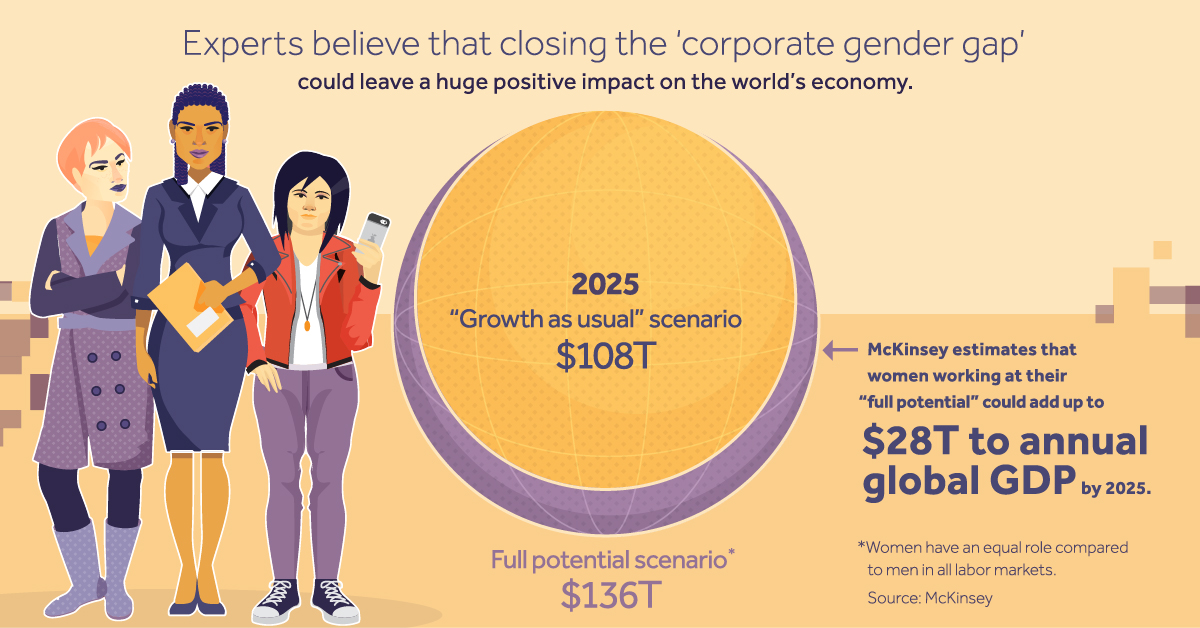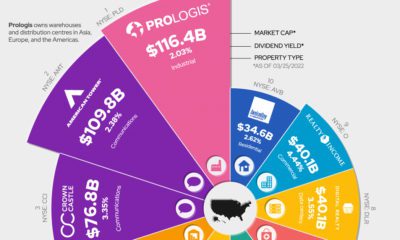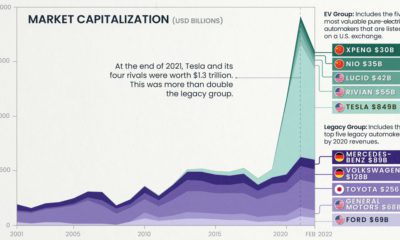5% of the richest billionaires are women 6% of S&P 500 companies have women CEOs 20% of Fortune 500 board members are women
There are many arguments that can be made for closing this gender gap, but the most compelling one is very simple: there’s a growing body of research that shows that gender diverse companies make more money.
Women and Profit
Today’s infographic comes to us from Evolve ETFs, a company that has launched an ETF focused on gender diversity, and it shows that companies with more women in senior roles are making better decisions and ultimately higher profits. Better Decisions The more diverse a team is, the more likely it is to make the best business decision. Logically, this makes sense, since multiple perspectives are considered this way – and groupthink can be avoided. There have been various studies on decision-making that show this, but one compelling example highlighted by Forbes covers 600 business decisions made by 200 different teams over a two year span. This research found that more diverse and inclusive teams made better decisions up to 87% of the time, took less time to make the decision, and delivered 60% better results. Better Bottom Line Not surprisingly, making better business decisions leads to bigger returns, as well. Credit Suisse, for example, found that boards with more women had a 36% higher return on equity. Meanwhile, research from Morgan Stanley found that the top-third of companies (that hire the most women) had 2% higher equity returns than average. A final study worth noting is from The Peterson Institute for International Economics, a Washington, D.C. think tank, which shows that companies with at least 30% female leaders end up raking in 6% higher net margins.
Future Growth
On the company level, gender diversity means more profit and better decisions – but what could this mean in aggregate? Global management consultancy firm McKinsey & Company offers up a rosy picture: they figure that if the gender gap is closed in their “full potential” scenario, up to $28 trillion extra could be added to global GDP growth by 2025. on These are in the form of Treasury securities, some of the most liquid assets worldwide. Central banks use them for foreign exchange reserves and private investors flock to them during flights to safety thanks to their perceived low default risk. Beyond these reasons, foreign investors may buy Treasuries as a store of value. They are often used as collateral during certain international trade transactions, or countries can use them to help manage exchange rate policy. For example, countries may buy Treasuries to protect their currency’s exchange rate from speculation. In the above graphic, we show the foreign holders of the U.S. national debt using data from the U.S. Department of the Treasury.
Top Foreign Holders of U.S. Debt
With $1.1 trillion in Treasury holdings, Japan is the largest foreign holder of U.S. debt. Japan surpassed China as the top holder in 2019 as China shed over $250 billion, or 30% of its holdings in four years. This bond offloading by China is the one way the country can manage the yuan’s exchange rate. This is because if it sells dollars, it can buy the yuan when the currency falls. At the same time, China doesn’t solely use the dollar to manage its currency—it now uses a basket of currencies. Here are the countries that hold the most U.S. debt: As the above table shows, the United Kingdom is the third highest holder, at over $655 billion in Treasuries. Across Europe, 13 countries are notable holders of these securities, the highest in any region, followed by Asia-Pacific at 11 different holders. A handful of small nations own a surprising amount of U.S. debt. With a population of 70,000, the Cayman Islands own a towering amount of Treasury bonds to the tune of $284 billion. There are more hedge funds domiciled in the Cayman Islands per capita than any other nation worldwide. In fact, the four smallest nations in the visualization above—Cayman Islands, Bermuda, Bahamas, and Luxembourg—have a combined population of just 1.2 million people, but own a staggering $741 billion in Treasuries.
Interest Rates and Treasury Market Dynamics
Over 2022, foreign demand for Treasuries sank 6% as higher interest rates and a strong U.S. dollar made owning these bonds less profitable. This is because rising interest rates on U.S. debt makes the present value of their future income payments lower. Meanwhile, their prices also fall. As the chart below shows, this drop in demand is a sharp reversal from 2018-2020, when demand jumped as interest rates hovered at historic lows. A similar trend took place in the decade after the 2008-09 financial crisis when U.S. debt holdings effectively tripled from $2 to $6 trillion.
Driving this trend was China’s rapid purchase of Treasuries, which ballooned from $100 billion in 2002 to a peak of $1.3 trillion in 2013. As the country’s exports and output expanded, it sold yuan and bought dollars to help alleviate exchange rate pressure on its currency. Fast-forward to today, and global interest-rate uncertainty—which in turn can impact national currency valuations and therefore demand for Treasuries—continues to be a factor impacting the future direction of foreign U.S. debt holdings.
















